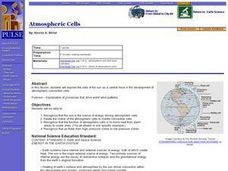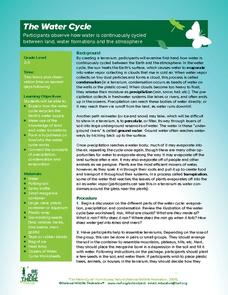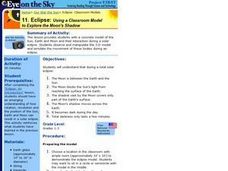Curated OER
Writing Exercises: Scientific Revolution
How is the Scientific Revolution evident in our lives today? Use this short-answer application and comprehension worksheet as your scholars explore this progressive era. Questions have learners explaining the scientific method and...
Curated OER
Water Cycle: Social Studies Online
If you need a presentation that describes the 3 elements of the water cycle then this PowerPoint could be a good starting point. This resource is basic in its presentation and formating, and only defines the words evaporation,...
Curated OER
Inner Planet Properties
In this planets worksheet, students complete a graphic organizer by determining their weight on that planet, its distance from the sun, the days it would take to travel from the Earth, and any other special features.
Curated OER
Earth
Fourth graders engage in a study of the solar system. The teacher constructs an outside model of it. They walk through it making constructive observations. Students conduct a class discussion about the solar system and planets. They...
Curated OER
The Path of the Sun: The Ecliptic
Learners investigate the celestial sphere and the paths it takes in the solar system.
Curated OER
3rd Rock from the Sun's Baby Rock
Seventh graders have a chance to actively see each phase of the moon and make connections to what they see in the sky when you show how the moon goes through each of the phases.
Curated OER
Measuring The Earth
Students use their geometry and trigonometry skills to determine the distance between their school and another school.
Curated OER
How Do Eclipses Occur?
In this eclipses worksheet, students write in the 4 steps explaining how an eclipse occurs. This worksheet is a graphic organizer.
Curated OER
Why Does the Moon Have Phases?
In this moon worksheet, students complete the sequence of the different phases of the moon to determine why the moon has phases. This worksheet is a graphic organizer.
Curated OER
Is the Earth Warming? a Test of the Effect of Increased Carbon Dioxide on the Thermal Properties of Air
Students investigate the environmental and economic effects of increased carbon dioxide (CO2) content in the atmosphere.
Curated OER
and and Ocean Views of Earth by Remote Sensing
Students explain how satellites help scientists to see more than with the unaided eye and how Landsat technology works. Students identify vegetation and fire sites in the rainforest and detect erosion along rivers. They are able to use...
Curated OER
Earth Processes
Fourth graders explore and discuss the process of evaporation. They discuss how wet things become dry. Students observe the process of evaporation and they make predictions about the observations they make about evaporation. Students...
Curated OER
Modeling Martian Motion
Students explore the difference between stars and planets and take on the role of these objects to simulate the relative motions of Mars and the Earth around the Sun.
Curated OER
The Tides of Change Worksheet (Part 2)
For this tides worksheet, students visit specified websites to view information. They explore the mass of the sun and moon, the force of gravity between two objects, and the ratio of the distances from the earth to the sun. Students...
Curated OER
Atmospheric Cells
Students recognize that the sun is the source of energy driving atmosphere cells. They relate the motion of the atmospheric cells to mantle convection cells. Students recognize that the function of atmospheric cells is to move heat from...
Curated OER
The Water Cycle
Students are introduced to the components and importance of the water cycle. They are shown how groundwater moves using a model. Students list 9 places on earth where water is found. They define the terms cycle and water cycle.
Curated OER
Astronomical Data
In this astronomy worksheet, students use a chart with planetary data comparing the inner planets to each other. Students will use the period of rotation, period of revolution, and distance from the sun for these inner planets to...
Curated OER
As the World Turns
Young scholars will use their bodies to act out the motions of Earth by exploring orbits, rotations, and the turning of the earth as it revolves around the sun. Doing research to find correct answers to their questions will help them act...
Curated OER
Reasons for the Seasons
Students discover how the Earth's axis of rotation affects the angle of sunlight and the length of day. They take a survey and give the survey out to family members and friends. They tally their findings and then determine the correct...
Curated OER
Eclipse: Using a Classroom Model to Explore the Moon's Shadow
Students manipulate and observe a 3-D model which simulates the activity of the Sun, Earth and Moon during a solar eclipse.
Curated OER
Alternate Tide of Change Worksheet
In this space science worksheet, students look up the mass of the sun and moon. They graph the results with the graphic organizer and answer the questions that are related.
Curated OER
Astronomy
Students explore the rotation of the Earth and observe the shapes of constellations. After discussing how the Earth moves. volunteers use a flashlight and globe to model the movement of the sun-Earth system. Using Digitalis technology,...
Curated OER
Melts in Your Bag, Not in Your Hands
Students study how the sun transfers heat to the earth through radiation. They examine how animals absorb energy from the sun to warm their bodies by experiment with chocolate melting. They examine sun safety.
Alabama Learning Exchange
Seasons
Learners explore the four seasons through literature, art activities and technology and explore how the earth's rotation around the sun results in the occurrence of the four seasons.
Other popular searches
- Earth Moon Sun System
- Earth Sun and Moon
- Earth/sun/moon
- Earth and the Sun
- Earth, Sun and Moon
- Earth and Sun
- Earth Moon Sun
- Earth Rotation Around Sun
- Earth and Moon and Sun
- Earth Orbit the Sun























